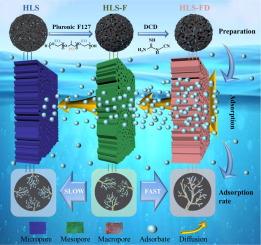Advanced biochar for accelerated and efficient pollutant removal in complex water systems
IF 8.1
1区 工程技术
Q1 ENGINEERING, CHEMICAL
引用次数: 0
Abstract
The adsorption efficiency of biochar for water pollutions is closely related to specific surface area (SSA) and pore size, especially in complex water systems. Here, hierarchical pores were constructed to evaluate adsorption efficiency in such system. Three biochar (Hydrothermal loofah sponge, HLS; Hydrothermal loofah sponge-pluronic F127, HLS-F; Hydrothermal loofah sponge-pluronic F127-Dicyandiamid, HLS-FD) were prepared using a combination of template and pyrolysis methods. The SSA of HLS, HLS-F, and HLS-FD were 1769.61, 1829.96, and 2057.43 m2·g−1, with microporosities of 78.14 %, 62.35 %, and 67.51 %. Compared to micropores (HLS), hierarchical pore (HLS-F and HLS-FD) exhibited more interface sites. The pore size adjustment reduced the equilibrium time for methylene blue adsorption from 480 min to 60 min. Since small molecular size, chloramphenicol (CAP) was rapidly adsorbed by all three biochar (60 min, 30 min, and 30 min), while for large molecular (sulfamethoxazole, SMX), HLS-F and HLS-FD showed significantly better adsorption rates than HLS (90 min to 30 min). Isotherm fitting results indicated that CAP and SMX adsorption by HLS-F and HLS-FD involved multilayer adsorption, confirming the presence of hierarchical pore structure. In binary systems, porous biochar maintained high adsorption capacity and pollutant removal efficiency. This study is significant for preparing hierarchical porous biochar (HPBC) and improving its adsorption performance and utilization efficiency, which lays a foundation for the preparation of selectively adsorbed biochar.

求助全文
约1分钟内获得全文
求助全文
来源期刊

Separation and Purification Technology
工程技术-工程:化工
CiteScore
14.00
自引率
12.80%
发文量
2347
审稿时长
43 days
期刊介绍:
Separation and Purification Technology is a premier journal committed to sharing innovative methods for separation and purification in chemical and environmental engineering, encompassing both homogeneous solutions and heterogeneous mixtures. Our scope includes the separation and/or purification of liquids, vapors, and gases, as well as carbon capture and separation techniques. However, it's important to note that methods solely intended for analytical purposes are not within the scope of the journal. Additionally, disciplines such as soil science, polymer science, and metallurgy fall outside the purview of Separation and Purification Technology. Join us in advancing the field of separation and purification methods for sustainable solutions in chemical and environmental engineering.
 求助内容:
求助内容: 应助结果提醒方式:
应助结果提醒方式:


